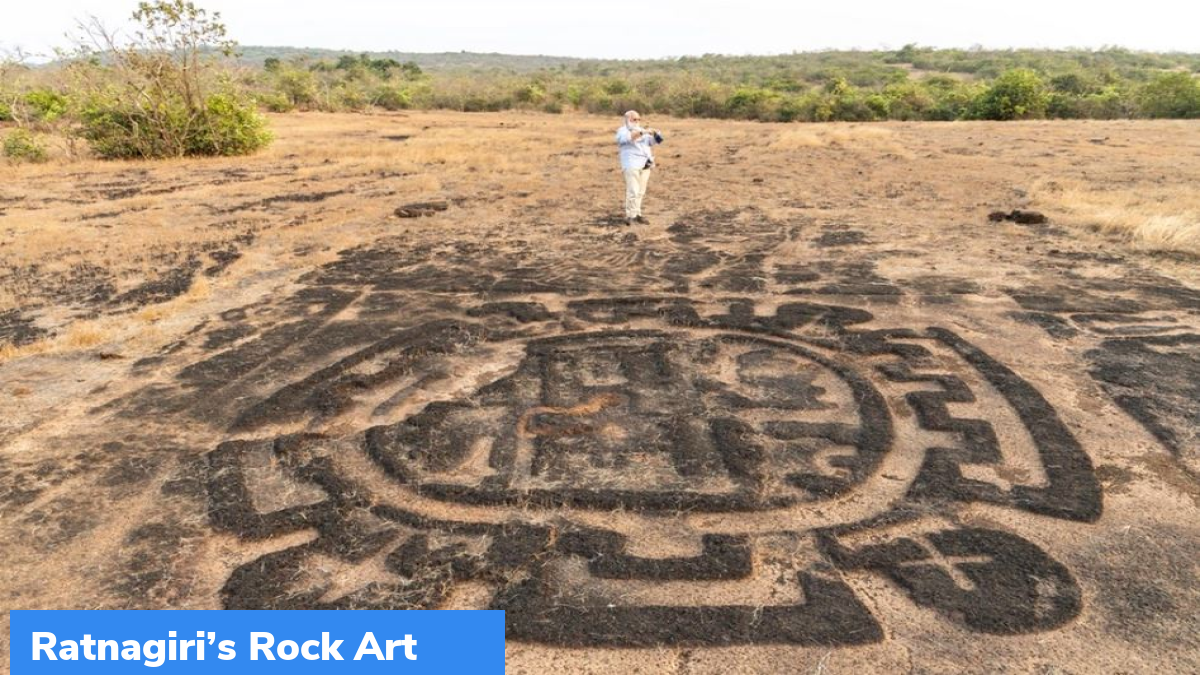Ratnagiri’s Rock Art
Experts have raised concerns about the location of the proposed mega oil refinery in Maharashtra’s Ratnagiri district as this project may cause damage to the prehistoric geoglyphs that are present in the region.
What are geoglyphs?
- The geoglyphs are a form of prehistoric rock art that is created by removing a part of the rock’s surface through an incision, picking, carving, or abrading.
- They are created on the surface of laterite plateaus, which are known as Sada in Marathi.
- This art can be in the form of rock paintings, etchings, cup marks, and ring marks.
- It is similar to the petroglyph, which literally means “rock symbol/character”. Both geoglyphs and petroglyphs require the skill of removing parts of a rock or engraving a rock to create a symbol.
Why is Ratnagiri’s prehistoric art significant?
- The Archaeological Survey of India and the state archaeology department are protecting the sites where the prehistoric rock arts are present in Ratnagiri district.
- These sites, situated in the Konkan region, were included in the tentative list of UNESCO’s World Heritage Sites.
- While UNESCO estimates these sites to be around 12,000 years old, several experts date them to be around 20,000 years.
- Clusters of geoglyphs are found across Konkan coastline in Goa and Maharashtra, spreading around 900 km. The entire region has a large number of porous laterite rocks, which are used for creating this ancient art.
- The Ratnagiri district has more than 1,500 pieces of rock art, which is known as “Katal shilpa.” These art pieces are found across 70 sites in the region.
- Seven sites in Ratnagiri district hosting petroglyphs have been featured the UNESCO’s tentative world heritage list. These sites are Ukshi, Jambharun, Kasheli, Rundhe Tali, Devihsol, Barsu and Devache Gothane.
- Other sites with the petroglyphs that were mentioned by the UNESCO list are Kudopi village in Sindhudurg district (Maharashtra) and 9 sites in Goa’s Phansamal.
- The Ratnagiri rock art provides evidence of the existence of human settlements from the Mesolithic (middle stone age) to the early historic era.
- The geoglyphs provide proof of the existence of certain types of fauna that are no longer found in the region.
- The rock art in the district shows how people adapted to ephemeral wetlands in a dry-arid plateau. It provided proof of human resilience and adaptation to extreme climatic fluctuations.
- It also provided evidence of advanced artistic skills as well as the evolution of the technique of etching and scooping in rock art.
Fauna that featured Ratnagiri District’s geoglyphs
- The faunas depicted in the Ratnagiri District’s geoglyphs include deer, elephant, tiger, monkey, wild boar, rhinoceros, hippopotamus, cattle, pig, rabbit, and monkey.
- The rock art also featured a large number of reptilian and amphibian animals like tortoises and alligators as well as aquatic animals like sharks and sting rays.
- Some of the clusters hosts one or two standalone figures that are larger than life. Others clusters featured multiple figures gathered together, seemingly on purpose.
- The Ratnagiri district hosts the largest geoglyph in India in Kasheli. This geoglyph features an enormous elephant with dimensions 18X13 metres.
Month: Current Affairs - December, 2022
Category: Art & Culture Current Affairs








